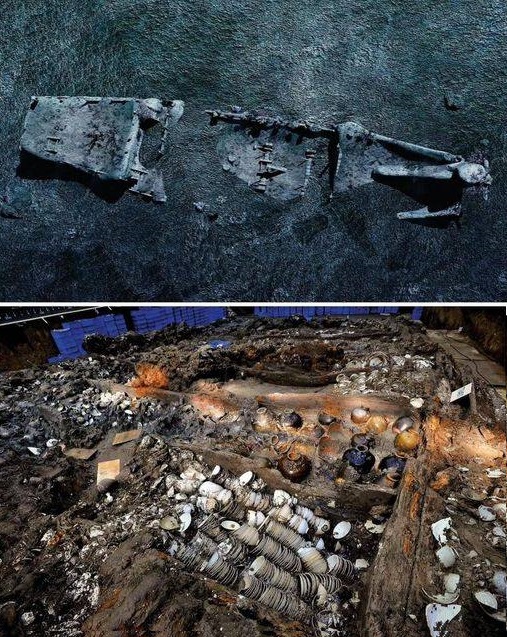The remarkable tale of the Nanhai One, a 12th-century Chinese merchant vessel, stands as one of history’s most fascinating maritime discoveries. This ancient shipwreck, holding over 60,000 artifacts, remained undisturbed beneath the South China Sea for centuries until its discovery in 1987. After a delicate and meticulously planned recovery in 2007, the vessel was transported to the Maritime Silk Road Museum of Guangdong, where it now rests in a specially designed saltwater tank. This preservation method ensures that the ship, along with its invaluable cargo, remains intact for future generations to study and admire.

The Nanhai One serves as a testament to the maritime excellence of the Song Dynasty (960-1279 AD). This period marked a golden age in Chinese seafaring, with extensive trade routes connecting China to the Arabian Peninsula, East Africa, and Southeast Asia. As commerce flourished, the Chinese built sophisticated ships capable of navigating vast oceans, transporting goods that would be exchanged across different civilizations. The Nanhai One exemplifies this global trade network, carrying a cargo that includes fine ceramics, luxurious silk, precious metals, and exotic spices. These artifacts paint a vivid picture of China’s economic dominance in the medieval world and its intricate trade relationships with foreign lands.
What makes the Nanhai One particularly extraordinary is its unparalleled state of preservation. Unlike many other ancient shipwrecks, which often deteriorate over time due to exposure to oxygen and marine life, this vessel remained relatively intact. Its hull, cabins, and cargo holds survived the passage of time, offering archaeologists an unprecedented look into medieval Chinese shipbuilding techniques. The ship’s structure reflects the advanced engineering of the Song Dynasty, showcasing the expertise of craftsmen who built sturdy and highly functional merchant vessels. Today, the Nanhai One continues to be preserved in a controlled environment, where researchers can analyze its construction methods and cargo distribution without the risk of deterioration.
The significance of this shipwreck extends beyond its artifacts and structure. The Nanhai One provides invaluable insights into the operation of the Maritime Silk Road, a crucial network that facilitated cultural and economic exchanges between China and the rest of the world. Each recovered artifact tells a compelling story of the vibrant trade that once flourished across Asia and beyond. The ship’s cargo reveals not only the goods that were traded but also the tastes, preferences, and demands of international markets during the Song Dynasty. This evidence underscores China’s role as a dominant economic force in medieval times, shaping commerce and culture across vast distances.
At the Maritime Silk Road Museum of Guangdong, the Nanhai One takes center stage as a historical treasure. Scholars and visitors from around the world come to witness this extraordinary find, eager to learn about the medieval global economy and the intricate trade systems that connected distant civilizations. The museum’s carefully curated exhibits highlight the ship’s artifacts, allowing people to appreciate the craftsmanship, artistry, and economic significance of the goods that were transported along the ancient maritime routes. This display bridges the past and present, enabling modern audiences to connect with the legacy of ancient seafarers and merchants.
Beyond its economic and archaeological significance, the Nanhai One also serves as a symbol of China’s enduring maritime heritage. The Song Dynasty, often regarded as one of the most innovative periods in Chinese history, played a crucial role in advancing naval technology, fostering international trade, and establishing China as a formidable maritime power. The discovery and preservation of the Nanhai One reinforce the importance of this era, reminding us of the ingenuity and ambition that propelled Chinese merchants across the seas.
As excavation efforts continue, new discoveries emerge from the depths of the shipwreck, providing further insights into the complexities of medieval maritime trade. The ship’s artifacts, from intricately designed ceramics to gold and silver treasures, reflect the diverse influences and interactions of different cultures. The distribution of cargo within the vessel sheds light on ancient loading and shipping practices, offering clues about the organization of trade expeditions. These findings contribute to a broader understanding of the interconnectedness of global commerce during the Song Dynasty and how maritime trade helped shape the economies of various regions.
The Nanhai One is more than just a well-preserved shipwreck; it is a living testament to China’s far-reaching influence in the medieval world. The ship’s discovery has revolutionized our understanding of ancient trade routes, shipbuilding technology, and cross-cultural exchanges. As researchers continue to analyze its secrets, the vessel enriches our knowledge of a time when Chinese merchants and sailors navigated uncharted waters, forging connections that would shape the course of history.
For future generations, the Nanhai One stands as an enduring legacy of exploration, commerce, and innovation. Its story highlights the resilience and ambition of the people who built and sailed it, carrying goods that not only sustained economies but also facilitated the exchange of ideas, customs, and traditions. The vessel’s preservation ensures that its historical significance remains accessible, allowing scholars, historians, and enthusiasts to uncover the complexities of medieval maritime trade for years to come.
In the grand narrative of human history, the Nanhai One occupies a special place as a bridge between past and present. Its remarkable journey from the depths of the South China Sea to the halls of the Maritime Silk Road Museum symbolizes the ongoing pursuit of knowledge and the dedication to preserving our shared heritage. As this ancient ship continues to reveal its secrets, it cements its status as one of the most significant archaeological discoveries of our time, offering a rare glimpse into an era when the seas connected civilizations and commerce flourished across continents.





